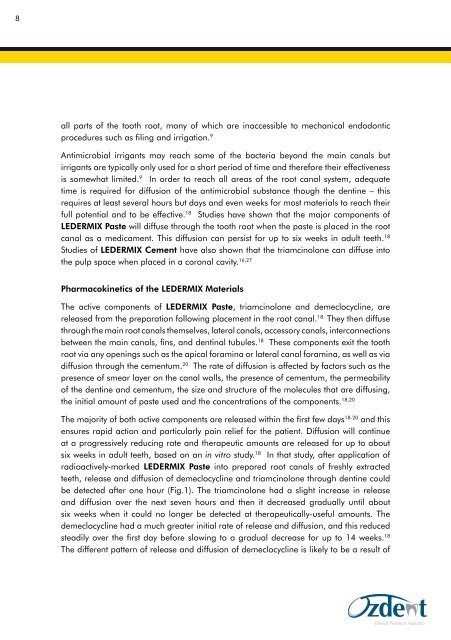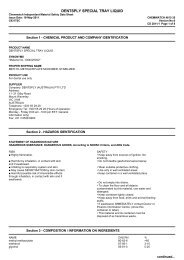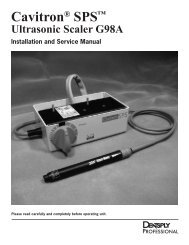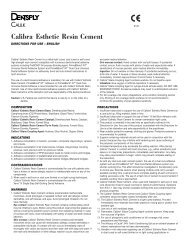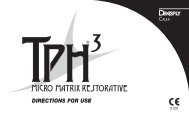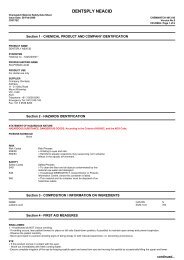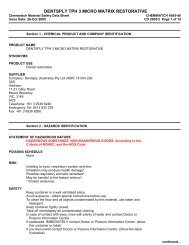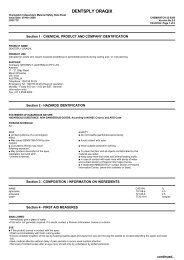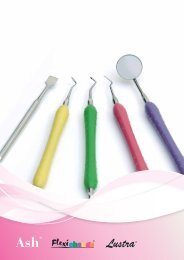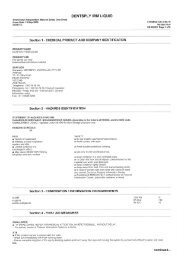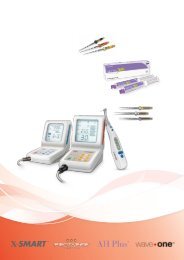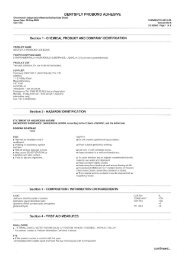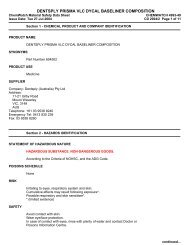The Materials - Dentsply
The Materials - Dentsply
The Materials - Dentsply
Create successful ePaper yourself
Turn your PDF publications into a flip-book with our unique Google optimized e-Paper software.
8 9<br />
<strong>The</strong><br />
<strong>Materials</strong><br />
all parts of the tooth root, many of which are inaccessible to mechanical endodontic<br />
procedures such as filing and irrigation. 9<br />
Antimicrobial irrigants may reach some of the bacteria beyond the main canals but<br />
irrigants are typically only used for a short period of time and therefore their effectiveness<br />
is somewhat limited. 9 In order to reach all areas of the root canal system, adequate<br />
time is required for diffusion of the antimicrobial substance though the dentine – this<br />
requires at least several hours but days and even weeks for most materials to reach their<br />
full potential and to be effective. 18 Studies have shown that the major components of<br />
LEDERMIX Paste will diffuse through the tooth root when the paste is placed in the root<br />
canal as a medicament. This diffusion can persist for up to six weeks in adult teeth. 18<br />
Studies of LEDERMIX Cement have also shown that the triamcinolone can diffuse into<br />
the pulp space when placed in a coronal cavity. 16,27<br />
the higher initial concentration in the paste (3.21% compared to 1% for triamcinolone)<br />
and the effects of the tetracycline binding with the calcium of the dentine. This latter<br />
effect helps to maintain the drug in the dentine for a longer period of time which is<br />
advantageous and provides some antimicrobial substantivity. 18,29<br />
pmol/min<br />
260<br />
100<br />
50<br />
Demeclocycline<br />
Triamcinolone<br />
Pharmacokinetics of the LEDERMIX <strong>Materials</strong><br />
<strong>The</strong> active components of LEDERMIX Paste, triamcinolone and demeclocycline, are<br />
released from the preparation following placement in the root canal. 18 <strong>The</strong>y then diffuse<br />
through the main root canals themselves, lateral canals, accessory canals, interconnections<br />
between the main canals, fins, and dentinal tubules. 18 <strong>The</strong>se components exit the tooth<br />
root via any openings such as the apical foramina or lateral canal foramina, as well as via<br />
diffusion through the cementum. 20 <strong>The</strong> rate of diffusion is affected by factors such as the<br />
presence of smear layer on the canal walls, the presence of cementum, the permeability<br />
of the dentine and cementum, the size and structure of the molecules that are diffusing,<br />
the initial amount of paste used and the concentrations of the components. 18,20<br />
<strong>The</strong> majority of both active components are released within the first few days 18-20 and this<br />
ensures rapid action and particularly pain relief for the patient. Diffusion will continue<br />
at a progressively reducing rate and therapeutic amounts are released for up to about<br />
six weeks in adult teeth, based on an in vitro study. 18 In that study, after application of<br />
radioactively-marked LEDERMIX Paste into prepared root canals of freshly extracted<br />
teeth, release and diffusion of demeclocycline and triamcinolone through dentine could<br />
be detected after one hour (Fig.1). <strong>The</strong> triamcinolone had a slight increase in release<br />
and diffusion over the next seven hours and then it decreased gradually until about<br />
six weeks when it could no longer be detected at therapeutically-useful amounts. <strong>The</strong><br />
demeclocycline had a much greater initial rate of release and diffusion, and this reduced<br />
steadily over the first day before slowing to a gradual decrease for up to 14 weeks. 18<br />
<strong>The</strong> different pattern of release and diffusion of demeclocycline is likely to be a result of<br />
0<br />
1h 3h 8h 1 Day 3 Days 10 Days 31 Days 14 Weeks<br />
Fig. 1 - Mean rates of release and diffusion (pmol/min) through<br />
human tooth roots of the active components of LEDERMIX Paste<br />
(from Abbott et al 18 )<br />
In the same study, 18 the concentration of demeclocycline within the root dentine was also<br />
measured. By the end of the first day, a concentration of 200 µg/ml was found in the<br />
dentine close to the root canal. A concentration gradient occurred across the dentine with<br />
concentrations of 21 µg/ml in the middle layer of dentine and 17 µg/ml in the dentine<br />
adjacent to the cementum. After one week, these concentrations reduced by a factor of<br />
about ten in all levels of the dentine. <strong>The</strong> concentration of demeclocycline in the dentine<br />
is high enough to inhibit most endodontic bacteria in the dentine immediately adjacent<br />
to the root canal in the first few days. However, the levels reached further out in the<br />
dentine and over longer periods was not sufficient to inhibit most bacteria that are likely<br />
to be present. 18 Hence, further antimicrobial strategies (e.g. the use of calcium hydroxide)<br />
should be employed to ensure complete disinfection of the root canal system prior to<br />
placement of the root canal filling. 6<br />
LEDERMIX Paste can also be used in a coronal cavity as a sedative dressing under a<br />
temporary restoration in cases of reversible pulpitis. <strong>The</strong> triamcinolone and demeclocycline


